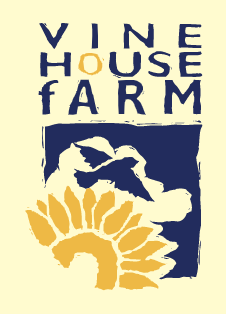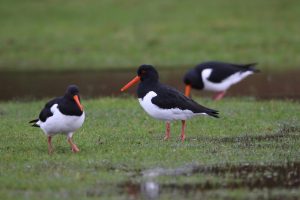
The wet weather has continued to dominate our activities on the farm. It was our wettest year since 1880 and most of it came in the second half of the year. Our average rainfall at Deeping St Nicholas is just 21 ins and we had 31ins. At Holbeach, only 10 miles away as the crow flies, the average is 24ins and they had 36ins. I can just imagine some are thinking ‘what on earth is he complaining about – our average is 40 or 50ins of rain every year!’ Whatever your average is, if you have 50% more than the average, it is far too much – especially when you should be cultivating the soil. December was again wetter than normal 62mm or 2.5ins; the December monthly average is about 45mm or 1.7ins. The month was slightly warmer than average. Since Christmas however we have had 10 days of very welcome dry weather.

Activities on the farm have been ploughing and cleaning dykes out, mainly on other farmers land or on land we have just purchased. We hired some land for potatoes, but the water on it couldn’t flow away because the dykes had not been cleaned out for many years. Once they were cleared, we were able to lift some of the potatoes.
This autumn we bought a farm adjoining one of our farms. It wasn’t a good time to buy a farm when the wet weather will undoubtedly mean less income for us, but land next door seldom comes up for sale. Most of the fields had not been drained in my lifetime. It has wet holes on it and the dykes also needed cleaning out. The water is now gradually disappearing from the fields since they have been cleaned out. For the past 15 years, this farm has been contract farmed – meaning the contractor has been sowing and harvesting and doing very little maintenance. More & more land throughout the UK is being farmed like this as farmers realise they are unable to make money from their farm, have nobody to take the farm over or are just looking for a quiet life. This isn’t good farming, every ounce of profit is being taken from that land.
In Lincolnshire, there are hundreds of acres of potatoes that haven’t been lifted and most potato fields have areas of standing water on them. As the land is basically level, the water does not flow into the nearest dyke and we have to rely on it soaking away through the soil – but the soil is full up.
The free price of potatoes – those that have not been grown on a fixed price – has risen by 50%, due to those that are still in the ground. This price rise won’t mean a price rise in the shops, as the supermarkets will not let their suppliers raise the price. In fact, prices of most root vegetables have gone down due to the price war between Lidl, Aldi and the other supermarkets, despite the increased costs, because of the wet weather that the suppliers have incurred. Who can supply 500gms of carrots and parsnips for 19p or even 15p?
The question remains, what should we grow on the acres not yet ploughed? It depends on when it stops raining – if it stops raining now, most land could be cropped. However, on the heavy land – containing a lot of clay – it may be better to fallow it and prepare the land for a good crop of winter wheat next year. On light land there are more options once the water has disappeared. It may be possible to crop the land as normal, but I expect there will be more spring barley sown than normal. Barley is worth less £s per tonne than wheat and the more we grow the less it will be worth.


I can’t see any signs that the wildlife on the farm has suffered from the wet weather. Barn Owls could have suffered, but we still have plenty of voles around, I see them diving into cover as I walk around the farm. If I can see them in the daytime, I am sure the Owls can find them at night. Fifty miles away things can be very different, along the North Norfolk coast I have twice seen Barn Owls flying during daylight hours, maybe voles are in short supply in North Norfolk.
Numbers of finches and buntings are building up through being fed every day but I haven’t seen a Brambling yet. More than half of the birds we are feeding are Chaffinches.
There are 500 to 600 ducks using our wetland, mainly Wigeon, they make a real spectacle when they take off. Wigeon feed on short grass, made available by 35 acres grazed by cattle in the summer. In November, cattle are replaced by sheep, as they graze the grass shorter than cattle. This makes it ideal for Wigeon and some Greylag Geese, and both keep it short for Lapwings to nest during April. A few cattle come back in April, not too many as we don’t want Lapwing, Redshank and Oystercatcher nests to be trodden on, but we do want the grass to be kept short.
Wigeon are winter visitors and will stay with us until early April when they make their way back north and east to their breeding grounds. Their numbers are keeping up better than Mallard as they breed in the wilds of Scandanavia and Russia, where man has little effect on the environment and there are still plenty of insects. Ducklings of course need insects to eat, goslings eat short grass and we are a nation of grass cutters, hence the reason why Canadas and Greylag Geese are doing so well here in the UK.
The coming summer should be good time for our farmland birds because there will be plenty of spring crops and the winter crops that have been sown have gaps in them. These gaps will give room for them to forage and weeds will grow so there will be more food available in the way of seeds and insects.
The Moorhens around our house pond have done very well this summer. Previously they had been declining, so I built them a little house on a pallet and floated it on the pond. They had two successful broods in the house – in previous years they were only getting one brood. The little house has been divided into two as Moorhens do not nest in the same nest twice, two compartments will give them space for two broods and the little house will need cleaning out each winter. The original idea of having two compartments was for Mallard to nest in the other side as we always have a pair of Mallard visiting the pond in the spring. Nesting in the little house meant that they were not predated, the young also had cover from predators and from the weather. It has also brought more movement into the garden.
Our pond is only large enough for one pair of Moorhens, so during the next two months there will be a few arguments and fights until only one pair remain on the pond. The rest of them will have to go to other ponds that we have dug not far away.
One of the reasons for the decline of Moorhens and Coots could be the increased population of Carrion Crows, who are constantly looking for eggs in the spring. Moorhens and Coots have to lay a full clutch of eggs before they start sitting and that is the time when the Crows find the nests, meaning that the birds have to start nesting all over again.
TALKS & Events
Winter Bird Watches at Vine House Farm
Saturday 18th January
Saturday 1st February
Tickets £7 – available on our website



